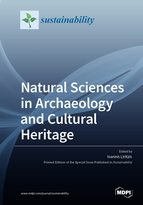Natural Sciences in Archaeology and Cultural Heritage
A special issue of Sustainability (ISSN 2071-1050). This special issue belongs to the section "Tourism, Culture, and Heritage".
Deadline for manuscript submissions: closed (15 June 2019) | Viewed by 71027
Special Issue Editor
Interests: preservation/conservation of monuments and artifacts; museology
Special Issues, Collections and Topics in MDPI journals
Special Issue Information
Dear Colleagues,
A Special Issue of the international journal Sustainability https://www.mdpi.com/journal/sustainability) under the section Sustainability of Culture & Heritage (https://www.mdpi.com/journal/sustainability/sections/culture_and_heritage) is planned to be entitled Natural Sciences in Archaeology and Cultural Heritage. The bridge between science/technology and the humanities (archaeology, anthropology, history of art, and cultural heritage) has formed a well-established interdisciplinary subject with several sub-disciplines; it is growing exponentially, spurred by the fast development of technology in other fields (space exploration, medical, military, and industrial applications). On the other hand, art and culture strive to survive from either neglect, lack of funding, or the dangers of events such as natural disasters and war. This volume will strengthen and exert the documentation of the sustainability of the issue, which arises from the outcome of resulting research and the application of such a duality link. The sustainable dimension emerges from the society, education, and economics through the impact of cultural growth, all of which, after all, produces a balanced society, in which prosperity, harmony, and development are merged to a sustainable local/regional/national/social level. A wide range of subjects linking applied natural sciences with archaeology and cultural heritage of innovative research and applications is anticipated to form this volume. Subjects include but are not limited to the keywords below. The deadline for submission of articles is 31st December 2018, and the envisaged publication, following peer review, is late spring 2019.
Prof. Dr. Ioannis Liritzis
Guest Editor
Manuscript Submission Information
Manuscripts should be submitted online at www.mdpi.com by registering and logging in to this website. Once you are registered, click here to go to the submission form. Manuscripts can be submitted until the deadline. All submissions that pass pre-check are peer-reviewed. Accepted papers will be published continuously in the journal (as soon as accepted) and will be listed together on the special issue website. Research articles, review articles as well as short communications are invited. For planned papers, a title and short abstract (about 100 words) can be sent to the Editorial Office for announcement on this website.
Submitted manuscripts should not have been published previously, nor be under consideration for publication elsewhere (except conference proceedings papers). All manuscripts are thoroughly refereed through a single-blind peer-review process. A guide for authors and other relevant information for submission of manuscripts is available on the Instructions for Authors page. Sustainability is an international peer-reviewed open access semimonthly journal published by MDPI.
Please visit the Instructions for Authors page before submitting a manuscript. The Article Processing Charge (APC) for publication in this open access journal is 2400 CHF (Swiss Francs). Submitted papers should be well formatted and use good English. Authors may use MDPI's English editing service prior to publication or during author revisions.
Keywords
- archaeometry
- geoarchaeology
- digital cultural heritage
- archaeoastronomy
- analytical techniques in archaeology
- STEM in Arts and Cultures (STEMAC)
- conservation of monuments and works of art
- new technologies in cultural heritage






